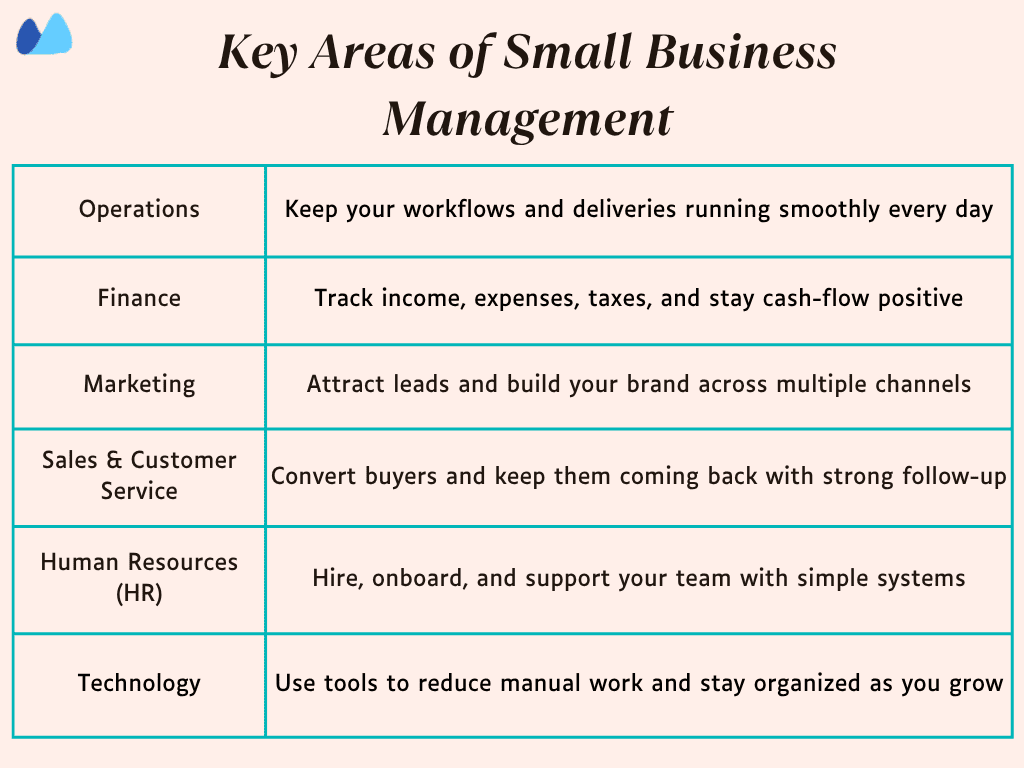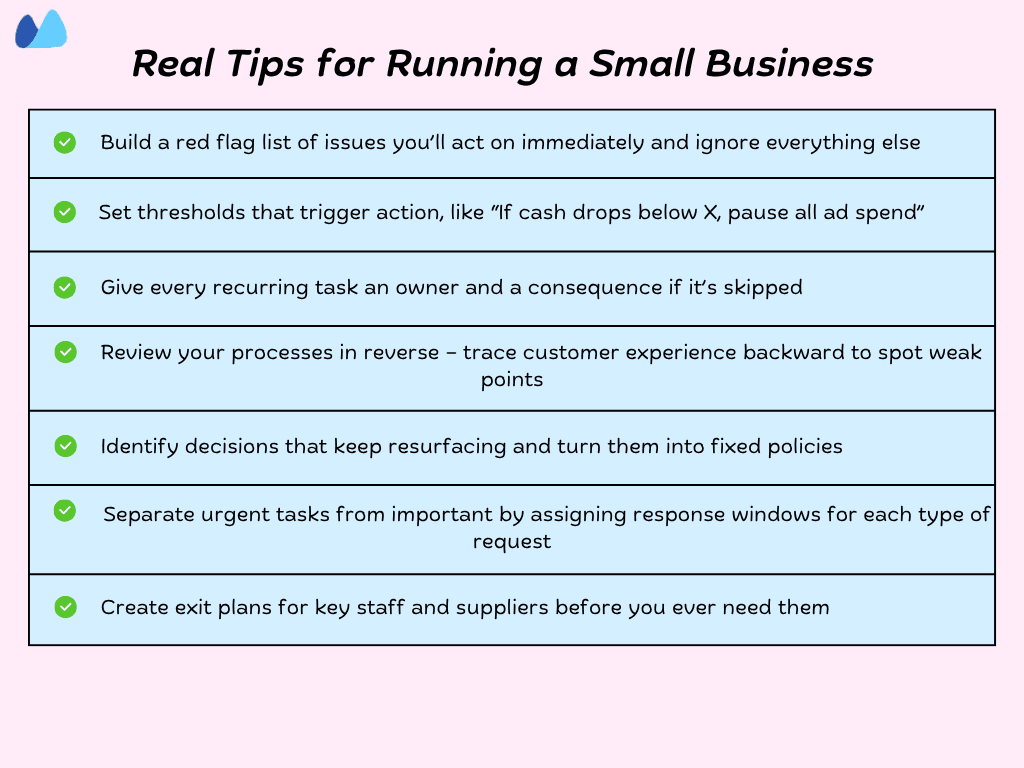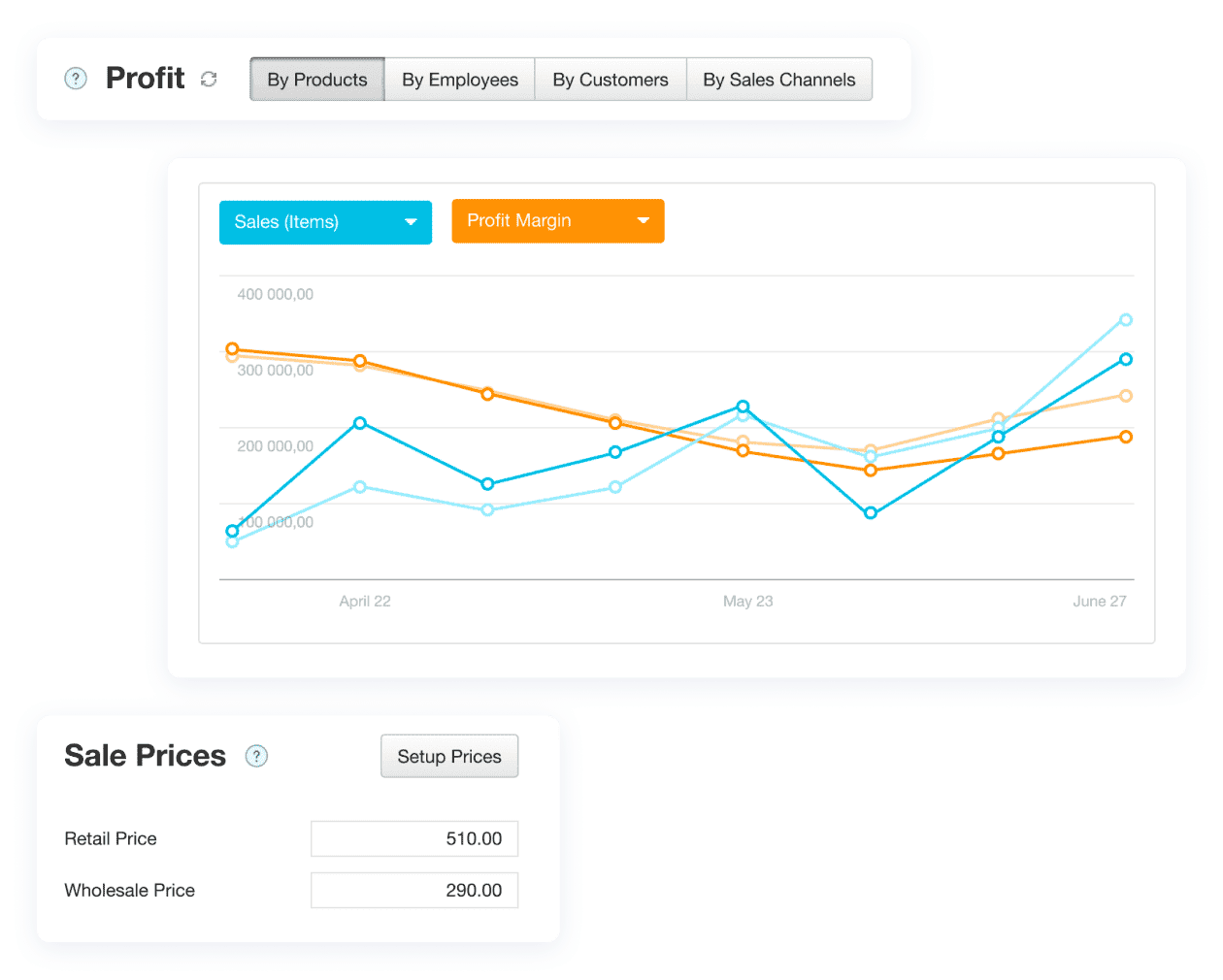Running a small business is more than just offering a good product or service; it’s about delivering exceptional customer experiences. It’s a daily balancing act across finance, operations, staffing, and strategy. Without strong management, even the best ideas stall. You wear many hats, juggle shifting priorities, and face challenges that big companies solve with entire departments.
That’s why small business management isn’t a skill. It’s a system. When you get it right, you gain control over chaos, grow steadily, and make smarter decisions without burning out.
And the shift is showing up in the numbers. PwC’s recent analysis shows that startups accounted for just 46% of company insolvencies in 2024, the lowest percentage in a decade. It’s not that failure has disappeared, but more small businesses are building systems that keep them afloat longer and scaling on purpose.
This guide provides a comprehensive overview of effective small business management. From planning to financial control to the tools and strategies that help you scale. Whether you’re just starting or looking to streamline operations.
You’ll find practical steps you can use today to improve how you’re managing a small business.
- What Is Small Business Management?
- Key Differences Between Managing a Small and a Large Enterprise
- Core Pillar of Managing a Small Business
- Tips for Effective Management of a Small Business
- Small Business Management Tools to Consider
- How to Choose the Right Tools
- Planning & Growth
- Common Challenges and Solutions in Small Business Operations
- Performance Tracking & KPIs
- Action Plan & Next Steps
- 📩 Download Free Templates: Small Business Management Toolkit by Kladana
- To Sum Up
- Frequently Asked Questions on Small Business Management
- List of Resources
What Is Small Business Management?
Small business management is the process of strategically planning, organizing, and overseeing every core function of a business.
It’s not just about keeping things running day to day. It’s about building systems, tracking performance, and making decisions that align limited resources with your long-term goals. Whether you’re working solo or leading a small team, effective management helps you scale without losing control.

Why it matters
Most small businesses don’t fail because of bad products but due to poor management. If you don’t work with a proper system, it’s very easy to burn out, miss targets, or lose customers to competitors who do a better job.
- Poor planning leads to missed revenue or supply issues
- Weak financial control drains cash and increases debt
- A lack of structure leads to team burnout or churn
- Inconsistent customer service damages loyalty
- Wasted time on manual tasks slows growth
Key Differences Between Managing a Small and a Large Enterprise
| Aspect | Small Business | Large Enterprise |
Decision-making |
Can make decisions quickly, and every choice has an immediate impact |
Decisions go through layers of approval, committees, and board rooms |
Budget & Resources |
Operates on a tight budget and must show ROI |
Budgets are large, with buffers for trial, testing, or waste |
Staffing |
Wears multiple hats, often founder, manager, and executor |
Teams are specialized, and roles are divided |
Tools & Systems |
Tools implementation that is affordable and easy to set up |
Invests in enterprise software with onboarding teams |
Flexibility |
You adapt fast, pivot products, adjust pricing, and respond to feedback |
Changes take time due to internal bureaucracy and risk aversion |
Customer Interaction |
You often interact directly with customers |
Handled by support teams or external teams |
Time Pressure |
Time is your asset. Every minute spent inefficiently slows growth |
It absorbs inefficiency better due to scale |
Survival Task |
One bad quarter ruins it majorly. But good small business management keeps you afloat |
Multiple safety nets and investors reduce existential threats. |
Core Pillar of Managing a Small Business
Strong small business management comes down to how well you handle these key areas. By implementing these areas, you will be able to establish a solid foundation for sustainable growth, even with a small team.
1. Planning and Goal Setting
Good planning helps you focus, measure progress, and avoid wasting time on things that do not require attention.
Here’s how to approach it:
- Set SMART goals (Specific, measurable, Achievable, relevant, time-bound)
- Break annual targets into quarterly and weekly plans
- Block time each month to review what’s working and what’s not
- Prioritize based on impact
2. Financial Management
Cash flow keeps your business alive. If you happen to mismanage the finances, the growth will become stagnant.
To manage finances well:
- Track your income and expenses every week
- Keep your personal and business accounts separate
- Set aside money for taxes even if your revenue is low
- Understand your break-even point and price with margins in mind
- Review cash flow weekly
📌 Example. A freelance designer struggled with late payments until they started using invoicing with auto-reminders. Within one quarter, their average payment time dropped from 28 days to 10 days.
3. Team Building and Leadership
Team building and leadership depend on the way you manage people. It impacts productivity, culture, and retention.
Your focus should be:
- To hire someone with a better personality and adaptability, not just experience
- Document roles and responsibilities early, even if it is a team of 3 people
- Delegate outcomes, not just tasks
- Supervise properly instead of micromanaging
- Celebrate wins and give feedback often
📌 Tip: Don’t wait for performance reviews. Give real-time feedback during your weekly stand-ups. It helps to build trust and keeps everyone aligned.
4. Marketing and Sales Strategy
A simple marketing strategy generates a good lead, and a smart sales process converts them.
A recent Adobe survey found that 60% of consumer prefers receiving offers by email over text. So, if you’re wondering whether email is still effective, it is. Just make sure it’s timely, helpful, and easy to act on.
What works for small businesses:
- Use your content and email marketing to build trust
- Keep your offers clear with visible pricing and outcomes
- Implement a basic CRM tool to track leads and follow-ups
- Focus on one or two marketing channels that already reach your audience
- Always measure your results, such as cost per lead, conversion rate, and repeat customers
📌 Example: A small D2C skincare brand doubled conversions by adding a WhatsApp CTA instead of a “Contact Us”, and removing friction made all the difference.
📘 Recommended Read: Want to improve your sales without adding more pressure? Dive into How To Improve Sales For Small and Medium-Sized Businesses. A step-by-step guide packed with follow-up tactics and practical strategies
5. Customer Service and Retention
It takes real effort to earn customers, and is even harder to keep them. Strong after-sales support and consistent communication are the things that turn one-time buyers into loyal brand advocates.
Your retention plan should include:
- Responding to inquiries or issues faster
- Following up after the sale to ensure satisfaction
- Offering loyalty perks or simple “thank you» gestures
- Creating a feedback loop to improve your product or service
📌 Tip: Set a calendar reminder to follow up with every customer after 7 days of their purchase. It shows you care and opens the door to upsells or referrals.
6. Technology and Software Tools
You can’t manage everything manually forever. The right tools save you time, reduce errors, and free you to focus on growth.
Look for software that helps you:
- Track projects, deadlines, and client requests
- Manage inventory & orders
- Automate accounting, payroll, and invoicing
- Store customer data securely
- Work remotely with your team in sync
📚 Related Reads to Grow Your Business
- 25+ Business Improvement Ideas — Practical ways to streamline operations and boost efficiency
- E-commerce Business Ideas & Trends — Stay ahead in online sales with emerging models and insights
- Wholesale Business Ideas — Explore profitable wholesale niches and strategies
- Production Business Ideas — Start or scale a small manufacturing venture
- Warehouse Trends — Modern warehousing practices reshaping supply chains
- E-commerce in Manufacturing — How manufacturers sell direct-to-consumer online
- Business Process Automation — Automate routine tasks to save time and reduce errors
Tips for Effective Management of a Small Business
Here are practical tips to improve how you’re managing a small business without adding complexity.

🚀 Scale Smarter — with Kladana by Your Side
Growth dashboards, KPI tracking, and strategic planning tools — Built for small teams scaling fast
Small Business Management Tools to Consider
As your business grows, managing everything manually only leads to delays and mistakes. That’s where the right tools help, not by adding complexity, but by giving you clarity and control.
Use these tools to manage business more efficiently.
📊 Finance & Accounting
- Kladana lets you track payments, sales, purchasing, and manage customers & suppliers from one dashboard
- QuickBooks helps you handle bookkeeping, Invoicing, and cash flow with ease
- Zoho Books is ideal if you’re in India and need GST billing with automation
📅 Project & Task Management
- Monday.com gives you the flexibility to plan tasks, timelines, and team workflows.
- Trello keeps your daily priorities organized with simple drag-and-drop boards
- ClickUp combines task management, docs, and planning in one workspace
🤝 Customer Relationship Management (CRM)
- HubSpot CRM is easy to use and helps you track leads, deals, and follow-ups
- Zoho CRM gives you lead scoring, email sync, and automation without overspending
🎺 Marketing & Communication
- Mailchimp helps you automate emails for newsletters, offers, and onboarding flows.
- WhatsApp Business is perfect for sending quick updates and support messages.
- Canva makes it easy to design graphics, promos, and pitch decks yourself
📦 Inventory & Operations
- Kladana provides real-time visibility into inventory, warehousing, and fulfillment within a single system.
- InFlow Inventory is helpful if you sell in bulk or need barcode scanning for B2B orders.
How to Choose the Right Tools
When you’re managing a small business, the right software acts like an extra team member. But only if it fits your workflow. You can check below on how to manage and choose wisely:
- Start with your top 2 bottlenecks, that is, late invoicing and missed deadlines
- Look for tools that integrate with cross-functional teams
- Prioritize tools that your team can lean in hours, not days
- Test before buying, because sometimes it happens that some tools offer free tiers or trials
- Limit yourself to 2–4 tools at a time to avoid digital clutter
Planning & Growth
As your business grows, you need a clear direction and systems that help you follow it. Without a proper plan, your business will not succeed. And that’s where strategic planning and growth systems come in. One keeps you focused. The other helps you scale without losing control.
Strategic Planning Steps
A simple, consistent planning routine keeps your goals visible, and your energy focused where it matters most.
- Define what success looks like in 6–12 months from now
- Break big goals into smaller targets you can review monthly
- Prioritize based on impact, not just urgency
- Set aside one day each month to check progress and course-correct
- Make your plan visible, whether it’s a dashboard, whiteboard, or shared doc
📙 Recommended Read: Not sure if your pricing is profitable? This guide on Break-Even Analysis for Small Businesses shows you how to calculate your breakeven point and make smarter financial plans with confidence
Growth Frameworks
Growth isn’t just about doing more; it’s about doing the right thing at the right time. You can apply some lightweight frameworks like:
- Lean Startup Loop ➞ Build ➞ Measure ➞ Learn. Use this when launching new offers or product features.
- SWOT Analysis ➞ Quickly assess strengths ➞ Strengthts ➞ Weaknesses ➞ Opportunities ➞ Threats to guide pivot or expansions
- TAM-SAM-SOM ➞ Estimate market size where you should focus. It is ideal if you’re exploring new geographies or verticals
- 80/20 Rule ➞ Focus on the 20% of the products or customers that drive 80% of results
📌 Tip: You don’t need an MBA for this. You just need frameworks that help you make more brilliant moves and avoid distractions. That’s the essence of effective management of a small business.
Common Challenges and Solutions in Small Business Operations
When you’re actively managing a small business, problems don’t always look big at first, but they compound quickly. Here’s how to spot them early and fix them with explicit action.
| Challenge | What’s Going Wrong | How to Fix It |
Cash flow gaps |
|
|
| Staff turnover |
|
|
Customer complaints |
|
|
Project delays |
|
|
Stock errors or fulfillment mistakes |
|
|
Burnout |
|
|
Real-World Example: Body Motion
🧵 Cash flow gaps often come from late invoicing, missed follow-ups, or failing to plan for lean months. Body Motion faced similar issues when double-buying tied up their funds. With automated invoicing, real-time stock control, and regular cash flow checks, they stabilized their finances and avoided unnecessary spending.
Performance Tracking & KPIs
KPIs aren’t just numbers; they help you solve problems faster and measure whether your decisions are working.
But as a small business owner, your time is limited. You can’t afford to track everything. The key is to establish a lean tracking habit that keeps you focused without overwhelming you.
| Step | What to Do | Why It Matters |
Set one goal per quarter |
Choose a focus area like delivery time and upsell rate |
Avoids random tracking. You only measure what supports your priority |
Choose 1–2 KPIs per goal |
Pick metrics that show movement, not vanity stats |
Forces clarity, such as what does improvement look like in real terms |
Track consistently |
Use a simple sheet or dashboard |
You build insight over time, not by glancing once at year-end |
Interpret before you act |
Ask yourself, «What does this number tell me?» Before changing anything |
Prevents you from taking wrong decisions based on one spick or dip |
Decide then document |
Every KPI review ends with: «Based on this, I will…» |
Transforms tracking into action, no wasted data collection |
Real-World Example: Neytt
🪡 Neytt adopted this lean KPI approach and, with 80% of their processes integrated into Kladana, gained full visibility over production, purchasing, and sales. They can now track performance in real numbers, calculate profit per project, and compare logistics costs per dispatch — all in minutes instead of hours. This shift turned routine tracking into actionable insights that drive faster, better decisions.

Action Plan & Next Steps
Managing a small business doesn’t require complex dashboards or hiring a full-time ops lead. You just need a simple system that connects your planning, operations, and growth, so that you’re not constantly switching from chaos to cleanup.
You can use the model below to structure how you can lead.
🧭 Level 1: Direction
- Set 1-2 business goals for the next 90 days
- Decide what not to do, such as features, markets, or tactics that distract
- Revisit these goals monthly, not daily, because they’re your north star
✅ This gives you direction, so you’re not just busy, but you’re building.
🎛️ Level 2: Control
- Choose 4–6 metrics to track weekly revenue, churn, fulfillment time, etc
- Use basic tools to review them weekly
- Check if your team, vendors, and processes are aligned with those numbers
✅ This gives you control so that decisions are made with data, not stress.
🚀 Level 3: Acceleration
- Your growth layer is where you gain leverage
- Identify recurring work so you can automate or delegate
- Build one SOP per month for anything you can touch twice
✅ This gives you momentum and growth that doesn’t rely on you working harder.
📩 Download Free Templates: Small Business Management Toolkit by Kladana
Don’t build every system from scratch. Kladana’s free templates help you manage your business with less guesswork and more control:
- Inventory Tracker: Stay on top of stock levels, reordering, and suppliers
- Production Schedule: Plan tasks, deadlines, and batches in one place
- Sales Report Sheet: Analyze revenue by customer, product, or region
- Quotation & GST Invoice Templates: Ready-made formats for smooth billing
- Daily Stock Sheet: Track Movement and closing balances with ease
- Bill of Materials Template: Map raw materials, quantities, and production costs
- Proforma Invoice Template: Create clear quotes that outline expected costs before final invoice
To Sum Up
Running a small business comes with pressure, unpredictability, and limited resources, but that doesn’t mean you need a complex setup.
Running a Small business management system, you should be grounded in planning, clear KPIs, strong workflows, and the right tools. Then, only you can stop firefighting and start leading.
You now have the structure to take control of your operations, you can grow without burnout, and make confident decisions.
Start one improvement at a time and build one habit. Try to fix one bottleneck, and that’s how businesses scale, step by step, on purpose.
Frequently Asked Questions on Small Business Management
What is Small Business Management?
It’s the process of running every part of your business, including operations, finance, HR, marketing, and more. You make decisions, solve problems, and set the direction, often without big teams or departments. Good management helps you stay in control while growing sustainably.
What are the core functions of small business management?
- Operations
- Marketing
- Sales
- Service
- HR
- Technology
How do I separate personal and business finances?
Start keeping separate bank accounts for both. Pay yourself a salary or draw, and keep receipts organized. This protects your records, simplifies tax preparation, and helps avoid legal trouble.
What role does technology play in small business management?
Technology helps you save time and reduce errors across invoicing, inventory, project tracking, and marketing. Simple tools enable you to automate repetitive tasks and organize your work without hiring additional staff.
What are the Key KPIs for a small business?
It depends on your business type, but standard ones include metrics such as revenue, profit, margin, customer retention, order volume, churn rate, and cash flow. Choose 5–6 items directly related to your current goals.
What are the four types of small business management?
Most businesses have four categories that is:
- Sole proprietorship
- Partnership
- Limited Liability Company (LLC)
- Corporation
How do I create a strategic business plan?
Start by defining where you want to be in the next 6 to 12 months. Break it down into clear goals, timelines, and milestones. Keep it simple, actionable, and reviewed monthly to ensure it stays relevant.
How should I manage staff effectively in a small team?
Be clear about roles, give ownership instead of micromanaging, and make time for regular check-ins. Invest in their growth, even if it is a slight improvement in skills.
What are the most common challenges in small business management?
Cash flow gaps, staff turnover, inconsistent operations, and poor planning are the most common. Many of these issues stem from a lack of a can-do attitude, and your challenges become more manageable.
How often should I review my business performance?
Monthly reviews help you catch issues before they grow. Track your key metrics, review what’s working, and adjust the course regularly to ensure optimal performance. A simple dashboard or spreadsheet is sufficient to get started.


